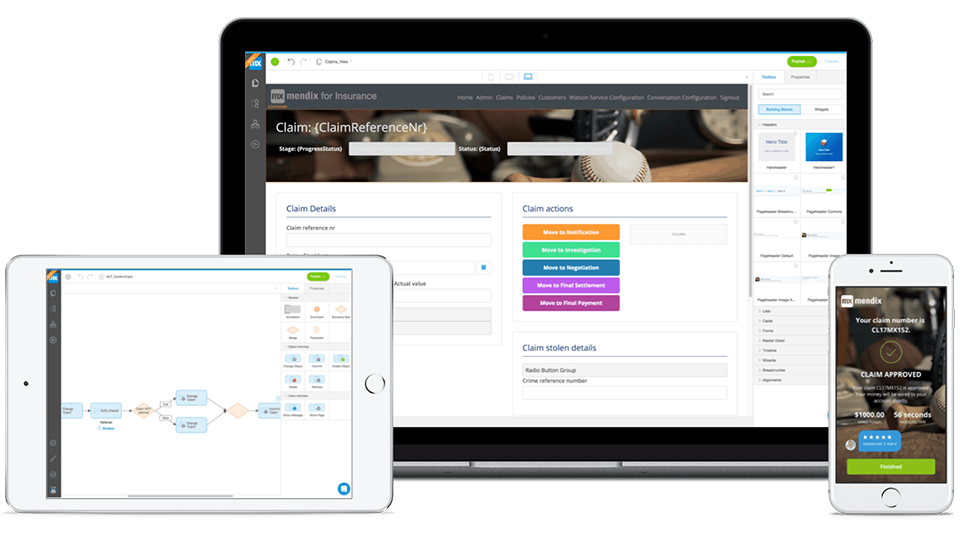Here’s a short background:
Today we often talk about ”systems of records,” abbreviated SOR. These systems are stable and comprehensive backbone business systems solutions, such as ERP, CRM or PLM. The thing about this type of complex platform is that you do not want to go in and change or update them too often because of that complexity. Here, solutions such as Mendix and what AppGyver develops—apps that allow you to easily create your own dashboards, presentation views and links to programs without coding—play important and facilitating roles. Low-code provides quick platform extensibility and can be used to create and facilitate customized consumption of data from the SOR and other related sources. In short, it’s a builder of bridges to easily connect more people, while at the same time limit access to exactly what is needed. In the case of Mendix, you only need to drag-and-drop to form a customized dashboard, as an example.
Businesses change quickly and often in the dynamic world we live in today. This means that to constantly sit and change the complex coding of your company’s backbone systems whenever the business requires new functions is not something you want to do. With solutions such as Mendix and those from AppGyver, it is easy to build on your ”system of records” in the app layer.

HUGE GROWTH POTENTIAL ACCORDING TO ANALYST GARTNER
This is attractive to companies and organizations all over the world, and analyst Gartner predicts that, “By 2023, over 50 percent of medium to large enterprises will have adopted an LCAP (Low-Code Application Platform) as one of their strategic application platforms.”
According to Gartner the formal definition of an application platform is “a product or suite of products that offers development, deployment and execution capabilities for any of user experience, business process, business logic and data.”
In this context, “an LCAP is an application platform that supports rapid application development, deployment, execution and management using declarative, high-level programming abstractions such as model-driven and metadata-based programming languages, and one-step deployments. LCAPs provide and support user interfaces (UIs), business processes and data services.”

SIEMENS SEES A HUGE POTENTIAL IN MENDIX
Real world results also confirm the explosive trend; Siemens, for example, sees a huge commercial potential.
Among the big PLM players, Siemens took an early lead when they bought the low-code developer Mendix. It didn’t take long for Siemens Digital Industries’ CEO Tony Hemmelgarn to perform a thorough evaluation of Mendix, and come to the conclusion that the company’s low-code could play a major role in Siemens’ Xcelerator portfolio, which in turn is linked to the IoT operating system MindSphere. The latter solution is the engine that picks up and manages data, while Mendix provides visual presentation and accessibility. As an example, it is extremely easy to build an app with a customized dashboard only by drag and drop functionalities.
For Mendix, they expect that annual doubling of sales volumes may be achieved. Even though it is currently estimated to sell for, let’s say, $100 million per year, doubling the revenue volumes means that in just a few years Mendix will become a powerful contributor when it comes to revenue generation in the company.
In this context, let’s also be clear that Microsoft already plays one of the leading roles in the LCAP arena with its Power Apps, which includes entitlements for Power Automate and the Common Data Service. Together, these form part of the Power Platform, which also contains Power BI for business analytics and Power Virtual Agents for low-code chatbots. Generally the analyst notes that, “Microsoft’s operations are in locations worldwide. Its customers are in a variety of industries and of varying sizes.”
Bottom line is that these platforms are growing, and according to Gartner, it will not be uncommon for companies, at least of a certain size, to have not just one low-code platform, but several.
“The market for low-code application platforms continues to grow with a high level of interest from Gartner clients in ’low code’” for both application development and other application-related uses such as integration and AI services,” Gartner concludes.
With prospects like this, it is hardly surprising that SAP also wants its own low-code capacity in-house.
“With AppGyver, we can in the future deliver a complete range of simple and integrated application development tools that enable customers, partners and our own teams to improve process automation and further improve the experience for users of SAP applications,” commented SAP’s Michael Weingartner, in a statement on the announced purchase of Finnish AppGyver.
However, a reasonable conclusion is that this doesn’t cause any short-term threats to how SAP will use the Mendix technology. In the PLM and product realization area few, if any, platforms better serve low-code needs than Mendix.

”NO IMMEDIATE CHANGES,”
SAYS APPGYVER’S CEO, MARKO LEHTIMAKO
That being said, AppGyver regards its Pro Composer platform as, “the world’s first professional no-code platform, enabling you to build apps for all form factors, including mobile, desktop, browser, TV and others.”
The company’s founder and CEO, Marko Lehtimaki, discussed the SAP purchase in a blog: “What happens now,” he wrote. “There will be no immediate changes to the product or anything else — you can continue to develop your existing and future projects as before. Everyone in the current AppGyver team will continue on, building the product and driving the vision; joining forces with a truly global technology powerhouse simply enables us to march towards our goals with orders of magnitude more resources. The platform development will progress much faster, and being part of SAP means you can count on us to not go away.”
He concluded that in the future, there will be integrations with SAP products, which will bring new opportunities to AppGyver’s enterprise customers. “In addition, we’ll continue to have exciting features and improvements in our product roadmap for indie and enterprise developers alike.”
A qualified guess is that SAP will orient its low-code work towards the ERP side, while Mendix will take care of the PLM and IoT-related pieces.
To read more on the AppGyver/SAP deal – click on this link to the full article at engineering.com:
They Had the Mendix Partnership But Bought AppGyver: Why is Low-Code so Attractive to SAP?






